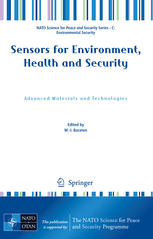

Most ebook files are in PDF format, so you can easily read them using various software such as Foxit Reader or directly on the Google Chrome browser.
Some ebook files are released by publishers in other formats such as .awz, .mobi, .epub, .fb2, etc. You may need to install specific software to read these formats on mobile/PC, such as Calibre.
Please read the tutorial at this link: https://ebookbell.com/faq
We offer FREE conversion to the popular formats you request; however, this may take some time. Therefore, right after payment, please email us, and we will try to provide the service as quickly as possible.
For some exceptional file formats or broken links (if any), please refrain from opening any disputes. Instead, email us first, and we will try to assist within a maximum of 6 hours.
EbookBell Team

4.3
68 reviewsThe NATO Advanced Study Institute on “Sensors for Environment, Health and Security: Advanced Materials and Technology” was held in Vichy (France) on September 16–27, 2007 where more than 65 participants, ranging from Ph. D. students to experienced senior scientists, met and exchanged ideas and know-how in a friendly atmosphere. The present book intends to cover the main topics of this NATO ASI through 32 chapters distributed over two parts (Part I: “Materials and Technologies” and Part II: “Applications to Environment, Health and Security”). The scientific programme of the NATO ASI consisted in 28 1-hour lectures given by 14 invited lecturers, 5 additional 1-hour lectures given by seminar speakers, 22 oral presentations by selected ASI participants and a poster session. The programme was divided into four sessions: (1) Advanced materials and technologies; (2) Sensors for environment; (3) Sensors for health; (4) Sensors for security. During the “Advanced Materials and Technologies” session (Part I of the present book), the lectures were dedicated to critical analyses of current methods for the synthesis of materials, nanomaterials (nanoparticles, nanowires, nanotubes, …) and nanocomposites to be used for the fabrication of sensing devices, mainly semiconductor sensors. Among the synthesis methods, chemical (sol-gel, etc. ) and physical methods (laser deposition, DC magnetron sputtering, etc. ) were discussed. Several lectures addressed characterization techniques and it was concluded that the physical and chemical control of the materials/nanomaterials, including surface chemistry, remains a key issue for the reproducibility of the final device.